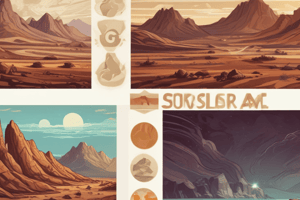Podcast
Questions and Answers
What is soil erosion, and how can it be prevented?
What is soil erosion, and how can it be prevented?
Soil erosion is the process of wearing away the topsoil. It can be prevented by implementing measures such as contour plowing, terracing, and planting cover crops.
What are the characteristics of fertile soil?
What are the characteristics of fertile soil?
- Adequate moisture, sufficient depth, rich in nutrients (correct)
- Excessive moisture, shallow depth, high nutrient content
- Adequate moisture, shallow depth, low nutrient content
- Inadequate moisture, deep depth, rich in organic matter
Soils are derived from parent rock material through a process of breakdown or wear and tear. Decomposed vegetal and animal remains, called ____, is an important constituent of soil.
Soils are derived from parent rock material through a process of breakdown or wear and tear. Decomposed vegetal and animal remains, called ____, is an important constituent of soil.
humus
Match the type of soil with its classification based on location:
Match the type of soil with its classification based on location:
Flashcards are hidden until you start studying
Study Notes
Soil
- Soil is a thin layer of loose mixture of small rock particles and rotting organic matter that covers the surface of the earth, supporting forests, grasslands, and crops, which are the source of energy for all living creatures.
Formation of Soil
- Soil forms through the breakdown of parent rock material by forces of nature like changing temperature, running water, and wind, as well as chemical and organic changes.
Soil Erosion
- Soil erosion is caused by faulty agricultural practices, overgrazing, and deforestation.
- Soil erosion can be prevented and conserved through improved agricultural practices, reduced grazing, and afforestation.
Constituents of Soil
- Soil is derived from parent rock material and consists of decomposed vegetal and animal remains (humus), silica, clay, and sand.
Soil Fertility
- Soil fertility refers to the ability of soil to support plant life.
- Fertile soil has adequate moisture, sufficient depth, is rich in nutrients (nitrogen, phosphorus, and potassium), and contains organic matter.
- Soil fertility can be improved by adding missing nutrients in the form of fertilizers.
Soil Classification
- Soils can be categorized as Residual or Sedimentary Soil (formed 'in situ' with a well-defined soil profile) or Transported Soil (formed 'ex situ' without a well-defined soil profile).
- Examples of Residual or Sedimentary Soil include black soil, red soil, laterite soil, and desert soil.
- Alluvial soils are an example of Transported Soil.
Types of Soil in India
- India has a variety of soil types due to its varied natural environment and different climates.
- Soil types in India are classified based on their origin, colour, composition, and location.
Studying That Suits You
Use AI to generate personalized quizzes and flashcards to suit your learning preferences.




